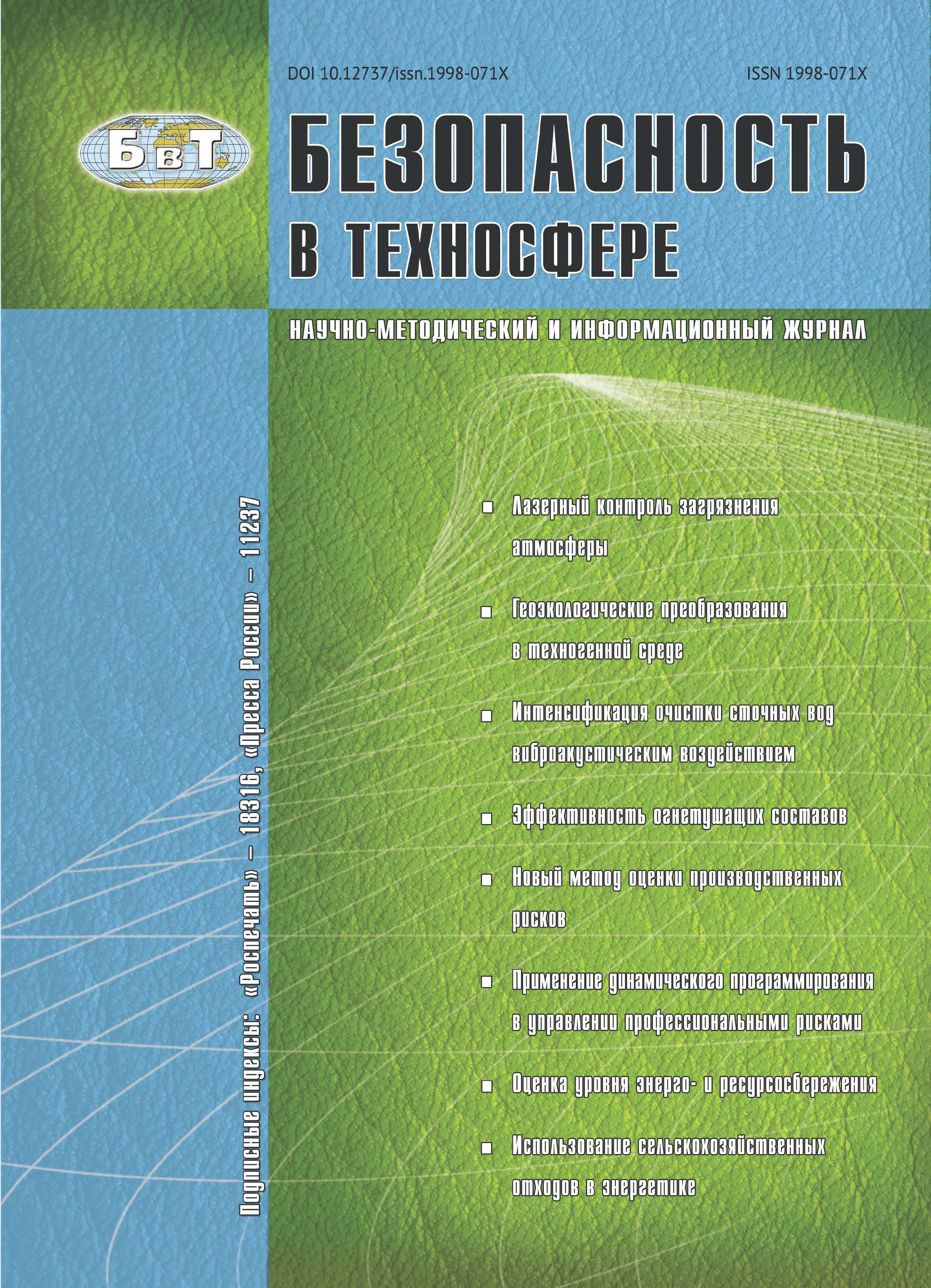Federal Educational and MethodologicalAssociation in the System of Higher Education «Technospheric Safety and Environmental Management» (Associate Professor)
Moskva, Moscow, Russian Federation
The article develops a stochastic model of suspensions separation in hydrodynamic filter. Suspensions separation in the filter is carried out due to hydrodynamic force action on suspension flow (first stage of separation) and filtering through a porous membrane (second stage). Pivoting perforated partition is put into filter in front of the porous filtering membrane to increase effectiveness of suspensions separation at stage one. Complex Couette flow develops in the gap between filter bowl and the perforated partition. Specific modes of flow in the gap produce Taylor vortex, size and intensity of which depend on parti-tion’s rotation speed and flow velocity. It produces a flow currently known as Couette-Taylor flow. Multidirectional Taylor vortex arising in the mainstream disrupts its hydrodynamics and creates turbulence. Given such flow, calculation of hard phase separation with use of determinate models can be an error as does not include stochastic processes. The article presents a new analytical model of suspensions separation, which takes in stochastic (probabilistic) separation processes and is based on the theory of Markovian processes. Equations of diffusion type, particularly the Fokker-Planck-Kolmogorov equation, are offered to describe process of suspensions separation in hydrodynamic filters with pivoting perforated partition.
hydrodynamic filter, Couette-Taylor flow, stochastic model, Markovian process, Taylor vortex, separation.
1. Введение
Для очистки жидкости от механических загрязнений в промышленности применяются гидродинамические фильтры, конструкции и принцип действия которых описаны в [1–3]. В [4, 5] с использованием моделирования в программных комплексах Ansys CFX и Star-CD установлено, что гидродинамическое фильтрование жидкости приводит к снижению нагрузки на фильтровальный материал, увеличению времени работы до регенерации фильтра, снижению перепада давления на фильтровальной перегородке. Однако к настоящему времени отсутствует полное математическое описание гидродинамических процессов в фильтре. Имеется ограниченное число работ, в которых описаны механизмы, реализуемые в гидродинамическом самоочищающемся фильтре [6–9]. Большинство из них касается непосредственно фильтрования без учета влияния всех механизмов очистки или при других схемах движения потока жидкости [10–12].
При очистке высоковязких жидкостей от мелкодисперсных взвесей в гидродинамических фильтрах требуется увеличить число оборотов фильтровального элемента. Для повышения эффективности работы гидродинамического фильтра предложено снабдить фильтр дополнительной вращающейся перфорированной перегородкой, при наличии которой повышается эффективность очистки.
В зазоре между корпусом фильтра и перфорированной перегородкой возникает сложное течение Куэтта–Тейлора, которое дестабилизирует поток жидкости. Расчет сепарации твердой фазы в таком течении с использованием детерминированных моделей может давать погрешности, так как не учитываются стохастические процессы. Мы предлагаем новую аналитическую модель разделения суспензий, учитывающую вероятностные сепарационные процессы и базирующуюся на теории случайных марковских процессов.
1. Devisilov V.A., Myagkov I.A. Hydrodynamic vibration filtering and designs of filters. Bezopasnost´ zhiznedeyatel´nosti [Life Safety], 2004, I. 7. (in Russian)
2. Devisilov V.A., Myagkov I.A. Mobil´naya ustanovka dlya vosstanovleniya otrabotannykh masel [Mobile installation for restoration of the fulfilled oils]. Bezopasnost´ v tekhnosfere [Safety in Technosphere]. 2007, I. 5, p. 36. (in Russian)
3. Devisilov V.A., Myagkov I.A. Hydrodynamic vibration filters in systems of cleaning and regeneration of the fulfilled oils and oil products. Ekologiya i promyshlennost´ Rossii [Ecology and industry of Russia]. 2005, I. 7, p. 4. (in Russian)
4. Devisilov V.A., Sharai E.Yu. Modelling of Work of the Hydrodynamical Filter With Use of the Program Complex. Bezopasnost´ v tekhnosfere [Safety in Technosphere]. 2009, I. 5, pp. 21-30. (in Russian)
5. Devisilov V.A., Sharai E.Yu. Modeling the flowing of the non-Newtonian fluid near the vibrating filtering baffler of the hydrodynamic. Bezopasnost´ v tekhnosfere. [Safety in Technosphere], 2010, I. 5, pp. 23-27. (in Russian)
6. Kholpanov L.P., Ibyatov R.I., Akhmadiev F.G., Fazylzyanov R.R. Mathematical Modeling of the Hydrodynamics over Permeable Surfaces. Theoretical Foundations of Chemical Engineering. 2003. Vol. 37, No 3, p. 207
7. Kholpanov L.P., Ibyatov R.I. Mathematical Modeling of the Dispersed Phase. Theoretical Foundations of Chemical Engineering. 2005. Vol. 39, No 2, p. 190
8. Schutyser M., Belfort G. Dean vortex membrane microfiltration non-Newtonian viscosity effects. Ind. Eng. Chem. Res. 2002. V. 41, № 3. P. 494.
9. Testik F., Voropaev S. On the case when steady converging/ diverging flow of a non-Newtonian fluid in a round cone permits an exact solution. Mesh. Res. Commun. 2004. V. 31, № 4. P. 477.
10. Testik F., Voropaev S. On the case when steady converging/ diverging flow of a non-Newtonian fluid in a round cone permits an exact solution. Mesh. Res. Commun. 2004. V. 31, № 4. P. 477.
11. Mochalin E.V. Features of behavior of weak suspensions through the punched rotating cylinder. Eastern-Evropean Journal of Enterprise Technologies. 2010. Vol.6, No 6 (48). p. 21-26 (in Russian)
12. Devisilov V. A., Sharai E. Yu. Hydrodynamics of a Rheologically Complicated Liquid in a Self-Cleaning Filter. Theoretical Foundations of Chemical Engineering. 2012. Vol. 46, No 6, pp. 594-600. DOI:https://doi.org/10.1134/S0040579512050119
13. Ternovskiy I. G., Kutepov A. M. Gidrotsiklonirovanie [Hydrocycloning]. Moscow, Nauka Publ., 1994. (in Russian)
14. Sivukhin D. V. General course of physics. V.1. Mechanics. Moscow, FIZMATLIT Publ.; MFTI Publ., 2002. (in Russian)
15. Protod´yakonov I. O., Chesnokov F. G. Hydromechanical bases of processes of chemical technology, Leningrad, Publishing house «Khimiya», 1987. (in Russian)
16. Korolyuk V.S. Reference book on the theory of probability and mathematical statistics. Moscow, Nauka Publ., 1985. (in Russian)
17. Landau L.D., Lifshits E.M. Physical kinetics. Moscow, Publishing house «FIZMATLIT», 2001. (in Russian)
18. Korn G., Korn T. Reference book on mathematics. Moscow, Nauka Publ., 1977 (in Russian)






